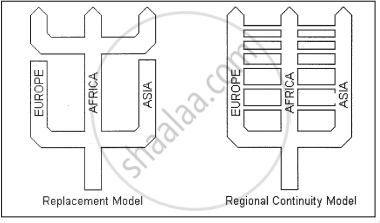Advertisements
Advertisements
प्रश्न
Discuss the arguments advanced in favour of the regional continuity model of human origins. Do you think it provides a convincing explanation of the archaeological evidence? Give reasons for your answer.
उत्तर
The regional continuity model states that the hominid ancestors had migrated from Africa and their further evolution took place in separate geographical regions. The remains of the mixed modern and archaic skull types found across the globe suggest that evolution of mankind took place simultaneously in different parts of the world; probably by the process of ‘genes flowing between populations.’

However, I do not believe that the evidence of the regional continuity model justifies the origin of humans. The replacement theory and its available evidences would be the best to justify it. According to this theory, Homo sapiens originated in Africa. Between 100,000–120,000 years ago, they migrated to Europe, Asia and Australia. This period was marked by the extinction of the earlier hominid species and the sustenance of Homo sapiens. Gradually and eventually, the Homo sapiens had spread across different parts of the world. This is regarded as the reason behind the degree of similarity among all modern humans (since they all have a common place of origin) by the replacement theorists. The fact that the oldest human fossil has also been excavated from Africa further reinforces my belief on the replacement theory.
APPEARS IN
संबंधित प्रश्न
Look at the diagram showing the positive feedback mechanism. Can you list the inputs that went into tool making? What were the processes that were strengthened by tool making?

Humans and mammals such as monkeys and apes have certain similarities in behaviour and anatomy. This indicates that humans possibly evolved from apes. List these resemblances in two columns under the headings of (a) behaviour and (b) anatomy. Are there any differences that you think are noteworthy?
Which of the following do you think is best documented in the archaeological record: (a) gathering, (b) tool making, (c) the use of fire?
Discuss the extent to which (a) hunting and (b) constructing shelters would have been facilitated by the use of language. What other modes of communication could have been used for these activities?
Choose any two developments each from Timelines 1 and 2 at the end of the chapter and indicate why you think these are significant.
